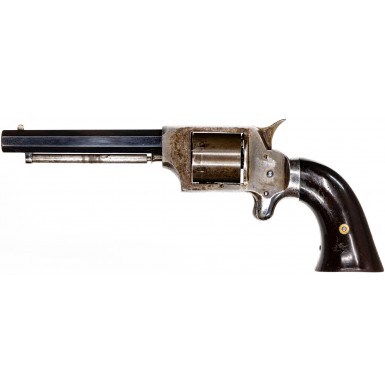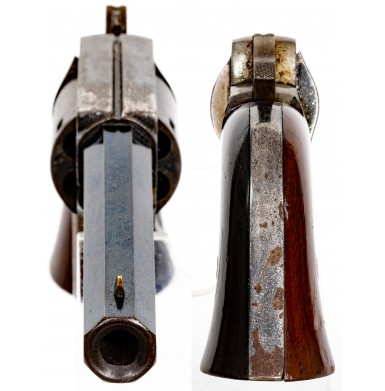Very Fine DD Cone Marked William Uhlinger .32RF Pocket Revolver
- Product Code: FHG-2427-SOLD
- Availability: Out Of Stock
-
$1,595.00
This is a really wonderful example of a William Uhlinger .32 Rim Fire Pocket Revolver. William P. Uhlinger produced about 10,000 rimfire cartridge revolvers, including two types in .22 caliber and one type in .32 caliber, in Philadelphia, PA between 1861 and 1865. He had purchased the tools and parts on hand of William Hankins, who had left his former gun making business behind to form a new venture with Sharps rifle inventor Christian Sharps, thus forming the firm of Sharps & Hankins. Since the guns that Uhlinger was producing were revolvers with bored-through cylinders, he was in violation of the Rollin White Patent, the rights to which were held by Smith & Wesson. As a result, many of Uhlinger’s guns were marked with a variety of trade names. These names included WL Grant, JP Lower, and DD Cone. Theoretically this was in an attempt to conceal the identity of actual manufacturer and avoid any legal troubles. About 50% of his pistols were also manufactured with no markings at all. It is assumed that Uhlinger felt this would help to avoid detection of his patent violations by Smith & Wesson. However, it did not. Uhlinger was eventually sued by Smith & Wesson for patent violations, and they won the case handily. The suit essentially put Uhlinger out of the gun business and resulted in his guns being little more than an interesting footnote in firearms history.
In reality, his solid frame, single action cartridge revolvers were well made and relatively successful. In an era where the total production of some successful handguns was measured in hundreds of units, with Allen & Wheelock being a perfect example of a successful maker with relatively low production of some models, his production totals which approached 10,000 units were a sign of their success and acceptance. There is no doubt that many a Union soldier went to war with a small frame Uhlinger .22RF pistol in his pocket for emergencies, and many line officers probably found the robust design of his solid frame .32RF pistol as a much sturdier choice for their personal defense than the Smith & Wesson #2 Old Army revolver.
The model offered here is one of Uhlinger’s D.D. CONE WASHINGTON D.C. marked, .32 rimfire pocket revolvers (Flayderman 8A-184) with a 5” octagonal barrel. The pistol is typical of the Uhlinger guns in that it is only marked with a trade name, in this case
D.D. CONE WASHINGTON D.C.
in a single line, upside down on the right side of the barrel. The only other markings are the serial number 1098. The number is found externally on the bottom of the grip frame, under the barrel where it is hidden by the ejector rod, on the side of the cylinder and on the inner edge of the loading gate. It is also found stamped on the inside of the two-piece varnished walnut grips. Research indicates that D.D. Cone was a Washington, D.C. patent attorney, who had no involvement in the sale or marketing of the revolvers. It is possible that Cone represented Uhlinger in some way, either filing patents or possibly defending him against his patent infringement, and this is how his name was selected for use on the guns.
The gun is in about VERY FINE condition. The pistol retains about 90%+ of its original bright blue finish on the octagonal barrel, which is thinning and shows some wear and loss along the sharp edges and points of contact. The barrel is almost entirely smooth, with only some very lightly scattered oxidized freckling present with some more moderate oxidation at the muzzle. The cylinder retains no blue and has a moderately oxidized brownish-gray patina with some scattered light roughness mixed with the oxidation. The iron frame was originally silver plated and much of that finish has flaked and been lost. Much of the frame retains only traces of the original silver, much of which has bubbled, resulting in the flaked loss. The largest areas of remaining silver on the backstrap and grip strap, as well as in protected areas around the sheathed spur trigger and on the frame to the rear of the recoil shield. The areas of the frame that have lost their silver have started to oxidize and develop a darker brown patina, with the backstrap showing patches of moderately oxidized brown metal with some roughness. The bore of the revolver is in VERY FINE condition as well and is mostly bright and shiny with crisp rifling and only some lightly scattered pinpricking and minor frosting in the grooves. The hammer retains some muted traces of its original color casehardened finish, with most of the hammer a dull gray with mottled traces of color. The gun is mechanically excellent. It times and locks up perfectly and the action remains very crisp. The gun retains two parts that are often missing or broken on these revolvers. The loading gate is original, complete, is numbered to the gun and fully functional. These gates are very thin, and they were built with a weak hinge, so they are often broken missing when the revolvers are encountered today. The other part that is often missing is the ejector rod. The rod has a stationary pin on one end and a spring-loaded pin on the other end. It snaps into place between the rod stop at the end of the barrel and the frame in front of the cylinder. The rod is present and functions exactly as it should, snapping securely into place under the barrel when not in use. The original brass blade front sight is present at the end of the barrel as well. The edges of the octagon barrel remain sharp, and the revolver is extremely crisp overall. The recessed and crowned muzzle is also in VERY FINE condition and shows only some light surface oxidation from use. The two-piece walnut grips are in about EXCELLENT condition. They are extremely crisp and retain about 90%+ of their original varnish. The grips are numbered to the revolver and show no breaks, cracks, or repairs. They show only the most minor light surface dings and handling marks.
Overall, this is a really wonderful example of one of the lesser-known cartridge revolvers of the mid-19th century. With only a few thousand produced, these guns are not regularly encountered and would fit in as well with a Smith & Wesson collection as an example of an early patent infringement or with any collection of the unique cartridge revolvers that were sold to the during the American Civil War. These guns are practically never encountered in this very high level of preservation; especially since these less expensive “working man’s” guns usually saw significant use and carry. This very crisp example will be very difficult to upgrade and will be a great addition to your Civil War revolver collection.
ON HOLD
Tags: Very, Fine, DD, Cone, Marked, William, Uhlinger, .32RF, Pocket, Revolver












